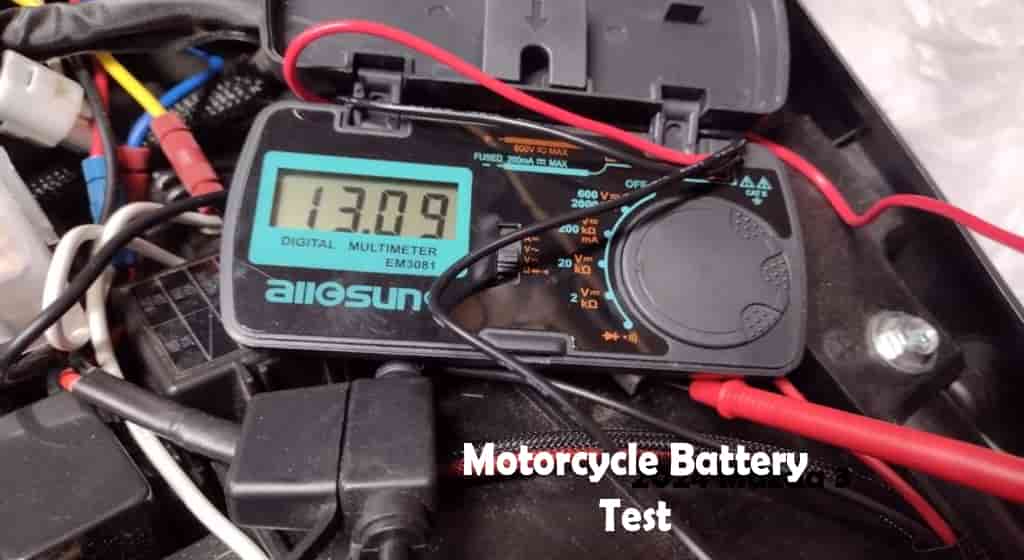Motorcycles are powered by their batteries and we will learn the easy steps on how to test a motorcycle battery. Regardless of how powerful your engine is, you cannot drive anywhere without a good battery. The motorcycle battery should therefore be tested regularly to determine its condition. This article will guide you on how you can test a motorcycle battery by yourself

things that you must remember before testing a Motorcycle Battery
Ensure you have a mechanical issue before you pull out wires or replace batteries. The side stand or the clutch lever must be engaged to produce power for modern bikes, which are equipped with safety switches.
The things that you need to remember are:
- Be Sure if there is an issue with the battery
- Properly inspect the battery
- You need to use a Voltmeter or Hydrometer
- Maintenance and Storage of the battery
- If you find out the main cause of the battery, you need to repair it.
What are the steps to check a Motorcycle battery?
The steps for checking a battery for a motorcycle are as follows:
01. Verify that you are experiencing a mechanical issue
You need to properly check for the issues and signs to make sure you are actually facing a mechanical issue. For Example, check if your clutch is pulled in or see if your motorcycle’s side stand is up.
Check the intensity of the light when you turn on your headlights to determine if your battery is faulty or dying. The light beams from your headlamps will often be weaker if your battery is damaged or dying, which is a good indication that you need to replace your battery. In spite of the fact that this is a useful measure, it is better to proceed to the next step for further diagnosis regardless of the outcome.
02. Take proper measures for safety
A battery should be tested by checking its basics and following safety procedures. Lead-acid batteries are common in motorcycle batteries. These lead-acid batteries are considered highly flammable. Throughout the testing process, you need to be extra careful. The best place to work is one that is well ventilated.
The battery should be kept away from sources of sparks or open flames. If there are any cracks or corroded terminals, inspect them. Make sure there are no leaks around the battery as well. As well as gloves and eye protection, we recommend that you wear protective gear.
03. Check the battery
Check your battery’s components for signs of corrosion, such as screws, clamps, and cables. An interruption in the flow of electricity can be caused by any kind of breakage or corrosion.
Once the components have been cleaned and secured, clean them with a wire brush. The battery case should be checked for apparent damage like cracks that could leak and affect the internal chemistry.
Ensure that your battery is dry and free of debris. Your battery could be discharged excessively due to dirt accumulating on the terminals, restricting the flow of current. If your battery terminals are grimy, you can clean them with a soft brush.
04. Battery load test and Static test
Static testing should be performed before a battery load test. It is used to determine whether the battery has been fully charged. In order to do this, there are two options. The charging system can be ignited while riding or a charger can be used. The battery should be cooled for at least one hour before testing.
The battery is not fully charged if the measurement is 12VDC or below. It has to be recharged before you go on. After charging, give the battery another hour or two to rest before running the test once more. The motorbike may be started using a completely charged and rested battery that measures between 12 and 12.6VDC.
Battery load testers should be used according to these steps:
- Work outside or in a room with good ventilation
- Place the voltmeter safely somewhere you can see it when you start the motorcycle.
- Verify that the motorbike is steady and that the transmission is in the neutral position.
- The positive battery terminal with the positive meter lead.
- The positive terminal of the battery should be connected to the negative lead of the meter
- The voltage should be read while the motor is starting and the results should be recorded
05. Utilize a voltmeter or a hydrometer
By measuring the specific gravity of the battery’s electrolyte with a hydrometer, you can determine the state of charge on most conventional batteries. Battery hydrometers should be inserted into cells after a battery has been charged.
You can now draw water into the hydrometer by pressing it near the bulb. After filling each cell, you may test each one by determining the fluid’s specific gravity. This number informs you if the cell needs to be replaced or is functioning well. It is likely that your battery has to be replaced if the hydrometer does not register the right specific gravity level for any cell.
A battery that is adequately charged has SG readings between 1.255 and 1.275, whereas a battery that is not sufficiently charged has SG readings between 1.215 and 1.235. Make sure you take these measurements in an environment with a temperature of 75 degrees.
06. Next Cranking voltage testing should be performed
While your battery is working, you can check the current flow from it by performing a crank voltage test. A digital voltmeter, for instance, can be hooked up and started. Voltmeters measure voltage while starters work. Over the course of 10 seconds, a properly functioning battery should remain over 9.6 volts.
Maintaining and storing the motorcycle batteries
Be sure to disconnect the battery cable from your motorcycle when storing it for the winter or not using it regularly. You should also ensure that the battery is maintaining its charge on a regular basis. It is important to check and recharge batteries more frequently when they are stored below 15 degrees and over 25 degrees.
Final Thoughts
Owning a motorcycle means having to deal with failing batteries. There is a limited lifespan for these components, and they will need to be replaced. Testing the battery according to the above procedures will help determine its condition. A new battery could be adversely affected by any battery discharge so it is important to check for the root cause.
